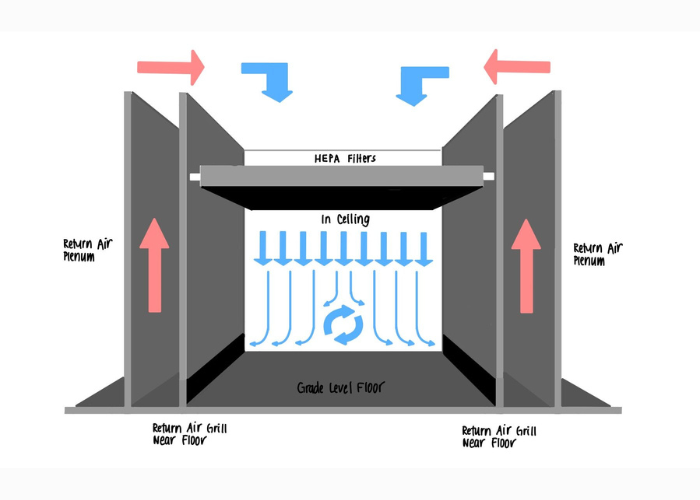The Science of Airflow: Why It Matters in Cleanroom Design
Cleanrooms are meticulously designed environments where maintaining cleanliness and minimizing contamination are critical. Among the many factors contributing to a cleanroom's effectiveness, airflow design stands out as one of the most crucial elements. Proper airflow management not only ensures compliance with stringent industry standards but also protects sensitive processes, products, and personnel. Let’s dive into the science behind airflow in cleanroom design and explore why it matters.
Understanding Cleanroom Airflow
Airflow in cleanrooms is engineered to control airborne particles and maintain specified levels of cleanliness. This is achieved through a combination of air filtration systems, directional airflow patterns, and pressure differentials.
Key airflow concepts include:
Laminar Flow: Air moves in a uniform, unidirectional stream, typically from ceiling to floor. This minimizes turbulence, ensuring contaminants are swept away and do not settle on surfaces.
Turbulent Flow: Air circulates in multiple directions, suitable for lower-class cleanrooms where stringent control isn’t as critical.
Pressure Differentials: Positive pressure prevents contaminants from entering the cleanroom, while negative pressure contains hazardous materials within the cleanroom.
Why Airflow Matters in Cleanroom Design
1. Contamination Control
Cleanroom environments are designed to limit the presence of airborne particles and microbes. Proper airflow ensures that contaminants are effectively filtered and removed, maintaining the cleanliness required for sensitive applications like pharmaceutical manufacturing, semiconductor production, and biotechnology research.
2. Regulatory Compliance
Cleanrooms must adhere to strict standards such as ISO 14644-1, which defines cleanliness levels based on particle counts. Airflow systems play a pivotal role in meeting these standards by ensuring air quality aligns with the designated classification.
3. Protecting Products and Processes
In industries like microelectronics and medical device manufacturing, even the smallest particle can compromise product integrity. Controlled airflow prevents contamination that could lead to costly defects or recalls.
4. Ensuring Personnel Safety
Airflow systems also protect personnel working with hazardous materials or processes. Negative pressure environments, for example, are essential for handling biohazards or chemicals, ensuring containment and minimizing risks.
Key Components of Cleanroom Airflow Systems
HEPA and ULPA Filters: High-Efficiency Particulate Air (HEPA) and Ultra-Low Particulate Air (ULPA) filters remove particles as small as 0.3 microns, ensuring clean air enters the workspace.
Air Changes Per Hour (ACH): The frequency of air replacement is crucial. Higher-class cleanrooms require more frequent air changes to maintain cleanliness.
Airflow Velocity: Proper airspeed ensures particles are carried away from sensitive areas without causing turbulence.
Environmental Monitoring Systems: Sensors track particle counts, airflow velocity, and pressure levels, ensuring consistent compliance.
Designing Airflow for Specific Applications
High-Class Cleanrooms (ISO 1–5)
These environments require laminar airflow to maintain extremely low particle counts. Industries like semiconductor fabrication and sterile pharmaceutical manufacturing often use vertical airflow patterns to ensure contaminants are quickly removed.
Mid-Range Cleanrooms (ISO 6–8)
Turbulent airflow is more common in these cleanrooms, which are typically used for less critical applications like medical device assembly or general laboratory work.
Best Practices for Cleanroom Airflow Design
Optimize Layouts: Ensure workstations, equipment, and personnel movement do not disrupt airflow patterns.
Regular Maintenance: Clean and replace filters as needed to maintain air quality.
Zoning: Separate cleanroom areas by cleanliness levels, using pressure differentials to prevent cross-contamination.
Monitor Airflow: Continuously measure particle counts, airspeed, and pressure to ensure consistent performance.
The Future of Cleanroom Airflow
Innovations like smart airflow systems and real-time monitoring technology are transforming cleanroom design. These advancements enable automated adjustments to airflow, ensuring optimal performance and reducing energy consumption.
Conclusion
The science of airflow is a cornerstone of effective cleanroom design. By carefully managing air quality, direction, and pressure, cleanrooms can meet rigorous standards, protect sensitive processes, and ensure safety. Whether designing a new cleanroom or optimizing an existing one, understanding and implementing proper airflow principles is essential for success in regulated industries.
About The Author
Darrell Drysen has over 25 years of experience in the Medical Device, Life Science, and Bio-Tech industries. As a technical leader, he holds patents in several fields including Brachytherapy, Electrophysiology, and Neurovascular implants. His outstanding ability to lead projects is evident from the numerous products he has taken from from concept through commercialization for both large companies and starts-ups. He joined ThermoGenesis in 2019 and is currently the Vice President of Operations.
Darrell holds certificates and degrees in Plastics Engineering Technology, Project Management, and Business Administration from California State University Sacramento and Cal Poly Pomona.
At ThermoGenesis CleanRooms, we provide ISO-compliant cleanroom solutions tailored to your industry. Contact us today to learn how we can help you build a cleanroom that supports your operational and compliance goals.



